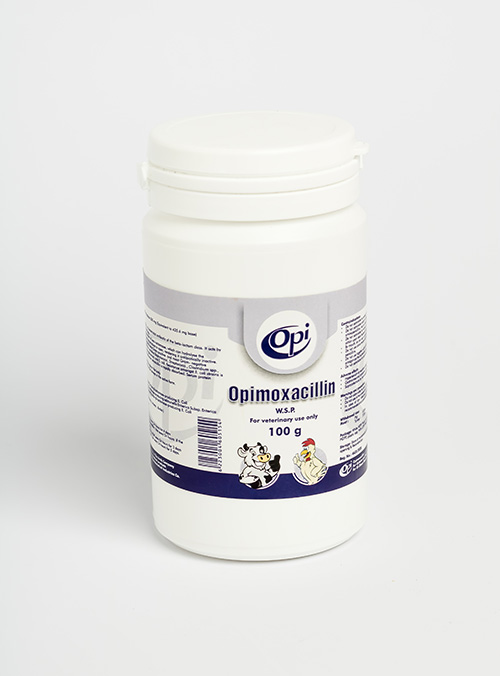Opimoxacillin
Dosage Form : Water soluble powder
Presentation:
Each 1 gm contains:
Amoxicillin trihydrate 500 mg
(Equivalent to 435.6 mg base)
Properties:
The active ingredient, Amoxicillin, is a bactericidal antibiotic of the beta-lactam class. It acts by inhibition of bacterial cell wall synthesis.
Amoxicillin is not resistant to the action of beta-lactamases, which can hydrolyse the molecules causing the beta-lactam ring structure to open, rendering it antibiotically inactive.
Amoxicillin is generally active against some Gram-positive and most Gram- negative Pasteurella spp bacteria e.g. penicillin sensitive Staphylococci, Streptococci , Clostridium spp., Salmonella spp., Haemophilus paragallinarum, and E. coli. Resistance amongst E. coli strains is not uncommon. Following oral medication amoxicillin is rapidly absorbed. Serum protein binding is low. Amoxicillin is widely distributed throughout the body.
Amoxicillin is mainly eliminated via the kidneys in the active form.
Indications:
Chickens: Broiler
– Colibacillosis, Peritonitis Caused By Non-β-lactamase-producing E. Coli
– Salmonellosis Caused By Non-β-lactamase-producing salmonella Enterica Subsp. Enterica
– Respiratory Tract Infections Caused By Non-β-lactamase-producing E. Coli
Target species : pigs
Birds (broiler chickens, turkeys , ducks )
For whole product
Pigs: 0.45 gm of opimoxacillin /kg every 24 hours for 4 days Broiler chickens: 0.34 gm of opimoxacillin / liter every 24 hours if the total treatment duration is of 5 days. Broiler ducks: Amoxicillin 0.45 gm/kg of BW every 24 hours for 3 days Broiler turkeys: 0.45 gm to 0.34 gm / liter every 24 hours for 5 days.Dosage and administration
For oral administration.Contraindications
*Do not administer to animals with a history of hypersensitivity to penicillin. *Do not administer orally to rabbits, guinea pigs and hamsters since amoxicillin, like all aminopenicillins, has an important action upon cecal bacterial population. *Do not administer to horses since amoxicillin, like all aminopenicillins, has an important action upon cecal bacterial population. *By mouth, do not use in animals with functional rumination. *Do not use concurrently with the neomycin since the latter blocks the absorption of oral penicillins. *Do not use together with antibiotics that inhibit bacterial protein synthesis since that can antagonize the bactericidal action of penicillins. *Do not administer in conjunction with bacteriostatic antibiotics. Adverse effects: *Hypersensitivity reactions whose severity can vary from simple hives to an anaphylactic shock. *Gastrointestinal symptoms (vomiting, diarrhea). *Suprainfections by non-susceptible germs, following prolonged use.Warnings and precautions
- Do not administer to laying birds whose eggs are intended for human consumption.
- Do not use in the 4 weeks prior to the beginning of the laying period or during the laying period.
- In case of any infectious process, a bacteriological confirmation of the diagnosis is recommended and a sensitivity test of the bacteria causing the process should be performed.






